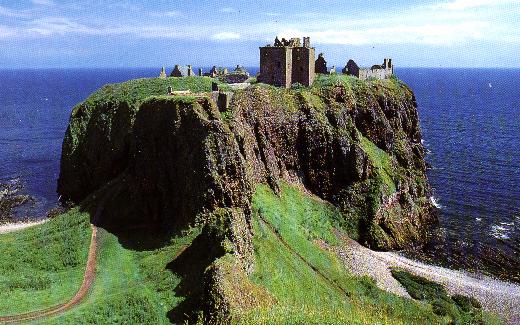
The first time I laid eyes on Dunnottar was almost magical...we were on the highway, heading towards the sea on our way home from a long day of sightseeing, and as we reached the top of an incline, everyone in the car said "ooh, there's the ocean". Now I love the sea, but the first words that came out of my mouth were something like "What's the name of that Castle?" I was awestruck- the sun was on it's descent from the sky behind us, and was casting it's orange rays upon this beautiful castle ruin... it made the walls look orange. We were able to stop, once we reached the castle area, but unfortunately, it was already closed, so I had to settle for some pictures.
We were in the area for a few days longer, but no matter how hard I tried; a trip to Dunnottar just wasn't in the making ... but I never forgot it, and read as much information as I possibly could find about it from that point onwards, until we went back to Britain almost 5 years later. This time I was determined to visit it, come rain or come hail, I was going to walk amongst the ruins of that castle, and dream my little dreams...
It had rained every day since we had arrived in Scotland, and that day was no different, yet it mysteriously stopped for a while whilest we paid our visit to the castle. It was miserably cold and quite windy, but we remained in good spirits throughout. The trek up to the castle was picturesque- across a field to the edge of a cliff, where a steep path made it's descent to the pebbled beach below. As it had rained so much prior to our visit, everything was pretty muddy, so the going was tough, but more adventurous, I felt.
Now, before going down the path, I should tell you a little about our surroundings, as well as the castle... as I said, it was a field, but to the right of us there was a small valley that dipped all the way down before coming up the other side again- it wasn't very wide but quite deep; one certainly wouldn't entertain the thought of jumping that gulley! There was a large waterfall on the other side of the 'ditch' that had collected all of the rain water and was guiding it down to the sea. There were Lambs and sheep abound- and balls of their wool billowing around the fields, catching in the long grass.
We eventually made it down to the bottom of the muddy cliff path, then followed the path to the castle's entrance (or gatehouse), which is actually built right into the rock. To say the least, the gatehouse is formidable, with its tall wall completely inscaleable. To the right of the gatehouse is a five story sixteenth century building, known as Benholm's Lodging. There are several gun-loops and loop-holes for arrows, that look over the pathway, providing the building with it's only light from that side, and adding yet more protection to the castle.
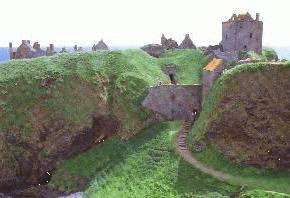
The most domineering structure of the castle is the tower house (or keep), and this structure, though missing it's roof, still stands at it's original height of about 50 feet as it did after construction, back in the 14th century. Total measurements of the keep are about 41 ft by 36 ft, with rubble walls built about 5 feet thick. The plans of the keep can be seen at the bottom of this page, along with the plans for the castle.
 |
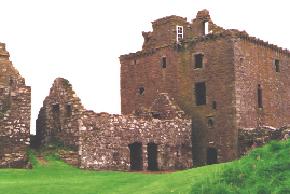 |
| The Keep and part of the Smithy | Keep & Storehouse |
The buildings next to the keep consist of the Storehouse, the Smithy, and the Stables. The storehouse appears to have been used for storing of ammunition, and also extra accomodation. The Smithy was the blacksmiths, and has a large arched fireplace, which is very much in ruin, but can still be seen. The stable block had room to hold maybe a dozen horses. There are also two chambers with privies (loos) within the stable block to accomodate the livery masters.
Heading out towards the middle of the castle rock, we find a separate building known as The Priest's House. It was called this as it was used by the priest of Dunnottar castle. It is also known as Waterton's Lodging. It is a two-story unvaulted house that contained private rooms, and a large hall. It appears that this building was used by the the family's son and his new bride.
Past Waterton's Lodging is the Kirkyard (also known as the church burial ground). After the kirkyard we find ourselves at the Kirk, or church, which forms part of 'The Quadrangle'. The Quandrangle was the most domestic part of the castle, being that it housed the well, living quarters, Large Dining room, Kitchen, Bakery and Brewhouse to name a few. All these buildings seem to have been built between the 16th and 17th centuries. The most infamous part of the quadrangle has to be Whig's Vault...This chamber lies underneath the private bedroom suite known as 'The King's Chamber' (so called after it was used by Charles II). Whig's Vault was originally used as a storeroom, but was turned into something much more sinister (read the section under Dunnottar's Famous History for more!).
The present chapel was built sometime in the 16th century, though it is said that there has been a chapel on this spot as long as there has been a castle on the rock, and that goes back to at least the 12th century, when castles were constructed with timber.
The Bowling Green as it is now, is a wide open space, and level, with the sides banked upwards. This is probably where the outdoor entertaining was held.
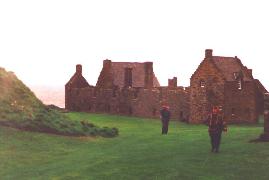 |
 |
| Eastern Quadrangle & Bowling Green | The Church (Kirk) |
Had enough yet? if not, read on to learn about Dunnottar's Famous (and infamous!)History.
Dunnottar is famous for keeping safely hidden, the royal regalia of Scotland- otherwise known as The Crown Jewels of Scotland. When Charles II made a second visit to Dunnottar in1651, he left the regalia with the castle. It wasn't long after that that Charles was exiled, and Cromwell's troups moved in. The seige at Dunnottar lasted 8 months and it was only the threat of starvation that caused the garrison to surrender to Cromwell's army. The castle was then ransacked for the treasure, all to no avail... the regalia had been smuggled out of the castle sometime during the Seige, and taken to a nearby village church, where it was buried under the alter for the next 8 years. The Regalia is now on display at Edinburgh Castle.
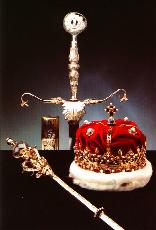
A number of cruel incidents have occurred throughout Dunnottar's history. It is said that When William Wallace captured Dunnottar in 1297 (at that point a timber stronghold), he burned alive some of the defeated garrison, in the church, of all places! In pretty much the same spot, several hundred years later, a witch was burned to death. But by far the most wretched incidences were still to come. It was 1685, and King James VII, a catholic king, had just been crowned- there was an uprising by the Protestants, also known as Covenanters. The revolt was soon ended, however, and the covenanters were imprisoned in Whig's Vault- all 167 of them- 45 of those being women. They were only fed as much as they could pay for.. the squallor of much crowded, unsanitory living conditions brought on many illnesses, killing several of the prisoners. In the end, several escaped, by climbing down the cliff's side (roughly 160ft!!)- only 25 managed to get away- the rest were recaptured, tortured, and re-imprisoned in another jail on the grounds (in the gatehouse).
It was 1715 that Dunnottar Castle was abandoned, after the keeper of the castle was involved in yet another ill-fated rebellion, and because of his involvement, the castle was forfeited, sold, and dismantled... and there the ruins have remained ever since, bringing people from far and wide to comtemplate them, and to imagine life as it must have been (good and bad) during Dunnottar's hey days.
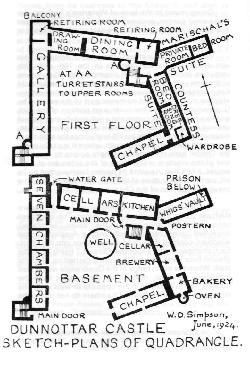 |